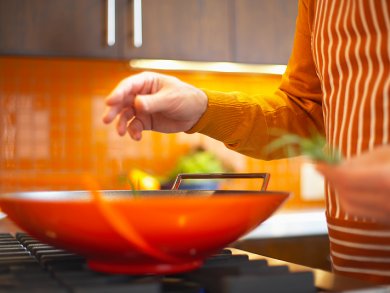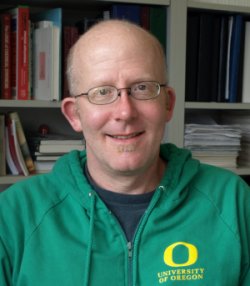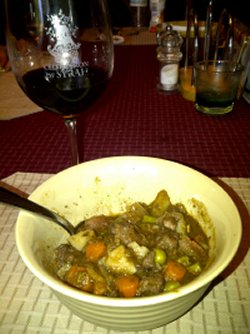Michael M. Haley is head of the Department of Chemistry at the University of Oregon, Eugene, USA. His research focuses on the exploration of important non-natural π-electron rich systems. M. Haley loves to cook and here he shares a special recipe for cold and rainy days in Oregon with us: Lamb Ragout.
In the Lab
What was your first experiment?
I started undergraduate research at the end of my sophomore year at Rice University in 1985. I spent that summer working with a graduate student on the reaction of Fe metal vapor co-condensed with EtOH at 77 K under irradiation. While the project failed to produce any substantive results in the end, it showed me that I loved doing research – the hook was set.
When was the last time you did an experiment in the lab – and what was it?
My last time in the lab was summer 2000, and I was working with an undergraduate in my group on a joint paracyclophane/dehydroannulene project with the Hopf lab in Germany. While I made a few molecules, the experience showed me that I no longer possessed the patience for lab work.
What is the most exciting experiment you did?
Hands down the most exciting experiment occurred during my 10-week visit to the Boese lab in Essen, Germany, in spring 1990. We managed to merge our ability to synthesize and isolate reactive molecules with their ability to grow single crystals of molecules directly on the diffractometer. We succeeded in obtaining the X-ray structure of 3,3’-bicyclopropenyl, the sole missing benzene valence isomer. The molecule had a melting point around −80 °C and decomposed above −10 °C.
What was your biggest experimental mishap?
As a postdoctoral researcher at University of California, Berkeley, USA, I was reducing one mole of cyclopropanecarboxylic acid to the corresponding alcohol using lithium aluminium hydride (LAH). In this reaction it is essential to keep the reaction temperature below 5 °C during the addition of the acid to the LAH suspension in ether. For reasons I have long forgotten, I failed to check on the reaction in a timely manner and when I returned to the hood the internal temperature was 15 °C and climbing.
Stupidly, I removed the melted ice water to replenish the ice, realizing too late that the cold water was the sole thing keeping the reaction in check. Within 20 seconds, the mixture violently exothermed, shooting the reaction out the top of the reflux condenser. Eventually, the pressure built up enough to shoot up into the air the 250 mL addition funnel that still contained most of the unreacted acid. While I managed to catch the addition funnel before it hit the counter, the pressure of the reaction had sheared off the glass adapter, which then sliced through the webbing between my middle two fingers as I “caught” the addition funnel. While I was very lucky that there was no fire, I did end up with LAH burns on my arm and three stitches between the fingers – OUCH!
What was the best advice you have ever been given?
The best advice I was given was as a starting assistant professor, and that advice was that “it is better to take no students than take on a weak student”. I ignored these words of wisdom, and regretted it for the next four years until that weak student left my group and the Ph.D. program. I tried my best to mold and shape the person in question, but some people are not cut out to be Ph.D. material. It took me a long while to realize that by letting this person go that I was not failing as an advisor.
On the Stove
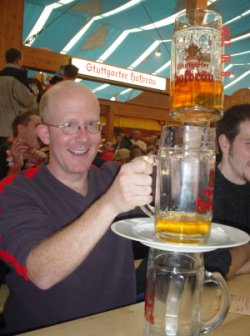
Please share your favorite recipe with us.
See below.
Please give some personal remarks why you chose this one.
This hearty, flavorful, well-seasoned stew is one of my favorite meals for the cool/cold rainy days of winter and early spring in Oregon. I have prepared this meal for dozens of friends, and every time people have gone back for second helpings, if not thirds!
If you were having a dinner party and could invite somebody, past or present, who would that be – and why?
I think it would be really interesting to have dinner with Linus Pauling. Given all of his contributions to chemistry, and science in general, not to mention him being from the state of Oregon, all this would lead to a dinner full of fascinating conversations.
Would you like to give some advice on cooking?
Recipes, either in the lab or in the kitchen, are nothing more that rough guidelines – never fear to innovate and improvise!
Michael M. Haley´s Recipe
Lamb Ragout
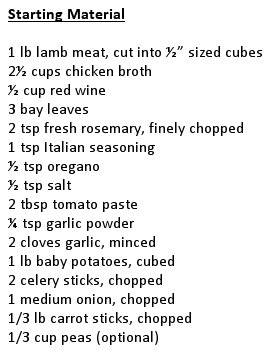
Directions:
Brown the meat in 1 tbsp oil in a large stew pot, and then drain. Add everything to the pot except the vegetables and slow cook for at least 30 min. Add vegetables (except peas) and cook for 10 min. Add peas and cook for another 10 min or until veggies are tender.
Serve the ragout in large, shallow bowls accompanied by a green salad and your favorite Rhone-style red wine. Salud!
A few notes:
- Lamb stew meat is OK, but I prefer leaner lamb shoulder or leg cuts with as much of the fat removed prior to cooking.
- I tend to under salt this dish, letting instead the herbs/seasonings dominate.
- Like a good stew, the flavors seem to be better integrated on day 2; thus, I will often prepare/slow cook the meat the night ahead and then cook the veggies the day of serving.
 Michael Haley was born in 1965. He graduated from Rice University, Houston, USA, in 1991, writing his thesis on “Synthesis and Structure of Cyclopropenes and Cyloproparenes”. He was a postdoctoral research associate at the University of California, Berkeley, USA, from 1991 until 1993. Afterwards, he moved to the University of Oregon, Eugene, USA, as Assistant Professor of Chemistry and was promoted to Associate Professor in 1999, and Full Professor in 2004. Since 2008 he has been the Head of the Department of Chemistry there.
Michael Haley was born in 1965. He graduated from Rice University, Houston, USA, in 1991, writing his thesis on “Synthesis and Structure of Cyclopropenes and Cyloproparenes”. He was a postdoctoral research associate at the University of California, Berkeley, USA, from 1991 until 1993. Afterwards, he moved to the University of Oregon, Eugene, USA, as Assistant Professor of Chemistry and was promoted to Associate Professor in 1999, and Full Professor in 2004. Since 2008 he has been the Head of the Department of Chemistry there.
His research focuses on non-natural π-electron rich systems and includes synthesis of organic semiconductors, synthesis and characterization of arylethynyl scaffolding for material sciences and supramolecular chemistry, as well as synthesis of heterocylces with uncommon cyclization reactions.
Selected Awards
- Fellow of the American Association for the Advancement of Science (2011)
- University of Oregon Fund for Faculty Excellence Award (2007)
- Herman Faculty Achievement Award for Distinguished Teaching (2002)
Selected Publications
- Synthesis and Optoelectronic Properties of 2,6-Bis(2-anilinoethynyl)pyridine Scaffolds,
J. M. Engle, C. N. Carroll, D. W. Johnson, M. M. Haley,
Chem. Sci. 2012, (3), 1105–1110.
DOI: 10.1039/C2SC00975G - Electron-Accepting 6,12-Diethynylindeno[1,2-b]fluorenes: Synthesis, Crystal Structures, & Photophysical Properties,
D. T. Chase, A. G. Fix, B. D. Rose, C. D. Weber, S. Nobusue, C. E. Stockwell, L. N. Zakharov, M. C. Lonergan, M. M. Haley,
Angew. Chem. Int. Ed. 2011, 50 (47), 11103–11106.
DOI: 10.1002/anie.201104797 - Arylethynyl receptors for neutral molecules and anions: emerging applications in cellular imaging,
C. N. Carroll, J. J. Naleway, M. M. Haley, D. W. Johnson,
Chem. Soc. Rev. 2010, (39), 3875–3888.
DOI: 10.1039/B926231H - Structure-Property Relationships of Donor/Acceptor-Functionalized Tetrakis(phenylethynyl)benzenes and Bis(dehydrobenzoannuleno)benzenes,
J. A. Marsden, J. J. Miller, L. D. Shirtcliff, M. M. Haley,
J. Am. Chem. Soc. 2005, 127 (8), 2464–2476.
DOI: 10.1021/ja044175a - Carbon Networks Based on Dehydrobenzoannulenes. 5. Extension of Two-Dimensional Conjugation in Graphdiyne Nanoarchitectures,
J. A. Marsden, M. M. Haley,
J. Org. Chem. 2005, 70 (25), 10213–10226.
DOI: 10.1021/jo050926v
- Author Profile: Michael M. Haley
Angew. Chem. Int. Ed. 2012, 51 (11), 2540.
DOI: 10.1002/anie.201108374 - See all Cooking in Chemistry interviews
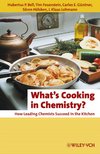 The idea to show what top scientists like to cook – on the bench and on the stove – is taken from the very successful book:
The idea to show what top scientists like to cook – on the bench and on the stove – is taken from the very successful book:
What’s Cooking in Chemistry: How Leading Chemists Succeed in the Kitchen
H. P. Bell, T. Feuerstein, C. E. Güntner, S. Hölsken, J. K. Lohmann,
Wiley-VCH, Weinheim, Germany, 2009.
ISBN: 978-3-527-32621-1
